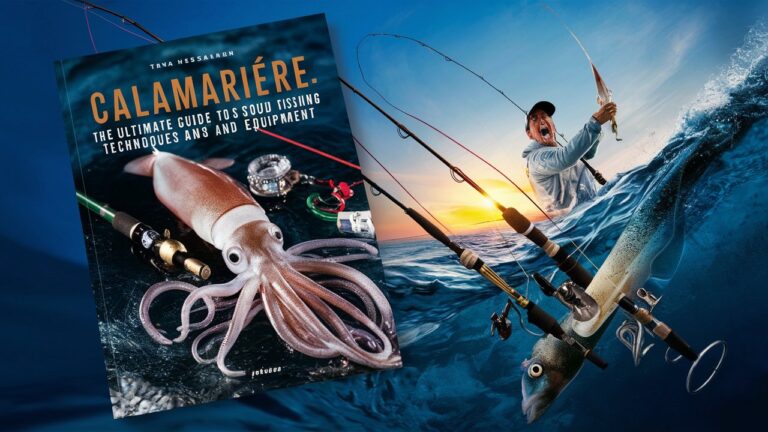Squid fishing has been a traditional practice for centuries, and one of the most effective tools used in this method is the calamariere. This specialized fishing gear is designed to lure and trap squid efficiently, making it a favorite among both amateur and professional fishermen. Whether you’re a seasoned angler or a beginner looking to explore squid fishing, understanding how a calamariere works, the best techniques for using it, and where to deploy it can significantly improve your catch rate. In this comprehensive guide, we’ll dive deep into the world of calamariere fishing, covering everything from its history and construction to modern-day applications and sustainability practices.
What Is a Calamariere?
A calamariere is a type of fishing trap specifically designed for catching squid. Traditionally made from woven nets or metal frames with bait compartments, these traps are submerged in water where squid are known to gather. The design allows squid to enter easily but makes it difficult for them to escape. Unlike active fishing methods like jigging, a calamariere is a passive system, meaning it works over time without constant supervision. This makes it an excellent choice for fishermen who want to set multiple traps and return later to collect their catch.
The History and Evolution of Calamariere Fishing
The use of calamariere dates back to ancient fishing communities, particularly in Mediterranean regions where squid was a staple food source. Early versions were crafted from natural fibers, but modern calamariere traps now incorporate durable synthetic materials and LED lights to attract squid more effectively. Over time, advancements in marine biology and fishing technology have refined the design, making calamariere fishing more efficient and environmentally friendly.
How Does a Calamariere Work?
The principle behind a calamariere is simple yet highly effective. The trap is baited with fish or artificial lures and lowered into the water, usually at depths where squid are active. Many modern calamariere traps also use LED lights since squid are naturally drawn to bright illumination. Once inside, the squid struggle to find their way out due to the funnel-like entrance design. Some fishermen leave the traps overnight, while others check them periodically, depending on local fishing conditions.
Best Locations for Calamariere Fishing
Squid are commonly found in coastal waters, especially near rocky seabeds, reefs, and underwater structures where they hunt for smaller fish. Some of the best regions for calamariere fishing include:
-
Mediterranean coasts (Italy, Greece, Spain)
-
East Asian waters (Japan, South Korea)
-
North American coastal areas (California, New England)
-
Australian and New Zealand shorelines
These locations offer rich squid populations due to favorable water temperatures and abundant prey.
DIY Calamariere: Can You Build One at Home?
For fishing enthusiasts who enjoy hands-on projects, constructing a homemade calamariere is entirely possible. Basic materials needed include:
-
A wire or plastic mesh frame
-
Bait compartment
-
Rope for lowering and retrieving
-
Optional LED lights for better attraction
There are numerous online tutorials that provide step-by-step instructions for building a functional calamariere without spending much money.
Calamariere vs. Squid Jigging: Which is Better?
While calamariere traps are excellent for passive fishing, squid jigging is an active method where fishermen use artificial lures to attract squid. Each method has pros and cons:
-
Calamariere Pros: Less labor-intensive, allows multiple traps, good for overnight fishing.
-
Calamariere Cons: Requires patience, may catch fewer squid in some conditions.
-
Squid Jigging Pros: Immediate results, more engaging, can be more productive in active squid zones.
-
Squid Jigging Cons: Requires constant effort, weather-dependent.
The best choice depends on personal preference and fishing conditions.
Sustainable Fishing with Calamariere
As overfishing becomes a growing concern, using a calamariere can be an eco-friendly alternative to large-scale commercial fishing. Since these traps are selective and minimize bycatch, they help maintain marine biodiversity. Additionally, LED-lit calamariere traps reduce the need for harmful chemicals or excessive bait, making them a responsible choice for conservation-minded anglers.
Conclusion
The calamariere remains one of the most effective and traditional methods for squid fishing. Whether you’re using a store-bought model or crafting your own, understanding its mechanics and optimal usage can lead to a bountiful catch. By choosing sustainable practices and selecting the right fishing spots, you can enjoy this ancient technique while preserving marine ecosystems for future generations.
FAQ About Calamariere
1. What is the best bait for a calamariere?
Squid are attracted to small fish like sardines or mackerel. Artificial glow-in-the-dark lures also work well.
2. How deep should I place my calamariere?
Most squid are found between 10 to 50 meters deep, depending on the region and time of year.
3. Can I use a calamariere in freshwater?
No, calamariere traps are designed for saltwater squid fishing.
4. Do I need a fishing license to use a calamariere?
Regulations vary by location, so always check local fishing laws before deploying traps.
5. How long should I leave a calamariere in the water?
Overnight is common, but some fishermen check traps every few hours for better results.
